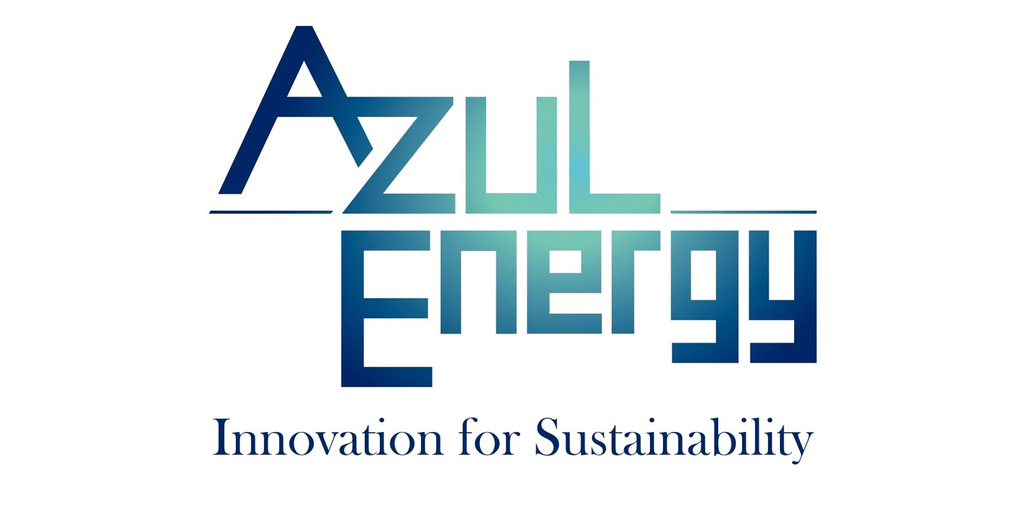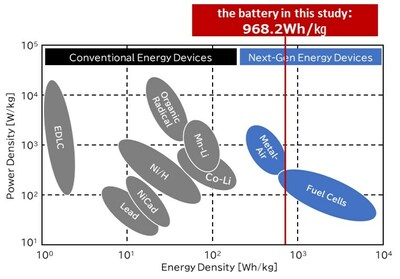
Pioneering Next-Generation Energy Devices with Environmentally Friendly "Metal-Air Paper Battery" Developed by AZUL Energy
Published by Todd Bush on April 10, 2024
SENDAI, Japan, April 10, 2024 /PRNewswire/ -- AZUL Energy proudly announces the development of a high-performance Magnesium-Air battery that is paper-based and activated by water.

A Metal-Air Paper Battery for Wearable Devices

Energy Density Comparison: Metal-air batteries have over three times the energy density of lithium-ion batteries on a weight basis.
>> In Other News: Johnson Matthey and bp Technology Chosen for the World's Largest Fischer Tropsch SAF Production Plant
A Metal-Air Paper Battery for Wearable DevicesEnergy Density Comparison: Metal-air batteries have over three times the energy density of lithium-ion batteries on a weight basis.
A research group, led by AZUL Energy Inc. (Sendai, JP), Professor Hiroshi Yabu from the Advanced Institute for Materials Research at Tohoku University, Senior Researcher Shinpei Ono from the Central Research Institute of Electric Power Industry, and Amphico Ltd (London, UK), has developed a next-generation energy storage device made from a safe, rare-metal-free AZUL catalyst and sustainable resources, including paper, magnesium, and carbon.
A significant breakthrough in energy storage technology, this battery generates electricity when immersed in neutral electrolytes like saline water, making it suitable for emergency power supplies and wearable devices. It achieves a voltage of 1.8V, an output exceeding 100mW/cm2, and a high capacity of 968.2Wh/kg.
Background
Conventional batteries use rare metals with limited reserves and high environmental impacts through mining, toxic heavy metals, and plastics. This research aimed to develop a sustainable and effective alternative in response to the growing demand for high-performance and environmentally friendly energy storage and usage.
Achievements
Although other "Metal-Air Paper Batteries" have previously been developed, they provided insufficient voltage and output, making them impractical.
In this study, the Magnesium-Air Battery provided a voltage of 1.8V, an output exceeding 100mW/cm2, and a high capacity of 968.2Wh/kg, representing a remarkable achievement. It was made using abundant and environmentally friendly materials, including magnesium, paper, and carbon, and a safe, rare-metal-free AZUL catalyst.
Future developments
Since our inception, AZUL Energy has focused on developing Metal-Air Batteries as next-generation energy devices. We have been working on enhancing their performance with our proprietary AZUL catalyst technology and have already improved the output and capacity of primary batteries. We are now entering the implementation phase for small primary batteries for sensors, hearing aids, drones, and more.
AZUL delivers excellent catalytic performance as a substitute for rare metals and is made from an environmentally safe blue metal complex pigment and carbon. It can fulfill various energy needs and is suitable for multiple applications, from small wearable devices to large batteries.
We continue to work on the charge-discharge compatibility and secondary battery conversion of Metal-Air Batteries, helping to foster a prosperous and sustainable society by introducing them into various applications.
Acknowledgments
Part of this research was supported by New Energy and Industrial Technology Development Organization (NEDO) International Co-Funding Program (JPNP14005).
About AZUL Energy
Established in 2019, AZUL Energy develops high-performance rare-metal-free catalysts invented by Tohoku University for next-generation energy systems. Although rare metal catalysts like platinum are used in hydrogen energy systems and are expected to reduce CO2 emissions, they are costly and have significant resource constraints. AZUL Energy's catalysts are lower cost and free of resource constraints, contributing to a more sustainable society.
SOURCE AZUL Energy Inc.
Subscribe to the newsletter
Daily decarbonization data and news delivered to your inbox
Follow the money flow of climate, technology, and energy investments to uncover new opportunities and jobs.
Latest issues
-
Can One Truck Fix Hydrogen’s Biggest Problem?
Inside This Issue 🚛 Alberta's Shared Truck Model Could Crack Hydrogen Adoption ✈️ ZeroAvia Completes Financing Round 🌾 Frontier And NULIFE Scale New Biowaste Carbon Removal Approach 🔥 WAGABOX® Of ...
-
North America’s Carbon Removal Year in Review: Winners, Losers, Surprises
Inside This Issue 🌎 North America's Carbon Removal Year in Review: The Deals, Policies, and Milestones That Shaped 2025 🚢 Hapag-Lloyd And North Sea Container Line Win ZEMBA Second E-Fuel Tender 🪨 ...
-
CCS Just Got Cheaper Than Anyone Expected
Inside This Issue 🧪 Shrinking the CCS Energy Penalty: A Molten Borate Breakthrough Promises Viability for Hard-to-Abate Canadian Oil & Gas 👤 Syntholene Energy Corp Appoints Former CEO of Carbo...
Company Announcements
-
WAGABOX® Of Steuben County, The First WAGABOX® Unit In The US
Deployment / Application Site Location: Bath, Steuben County, New York, USA Site/Plant name: Steuben County Landfill Partners/Clients: Steuben County (landfill owner), Corning Natural Gas (...
-
ZeroAvia Completes Financing Round
KEMBLE, UK and EVERETT, Wash., Dec. 22, 2025 /PRNewswire/ -- ZeroAvia today announced that it has completed a further round of financing, led by Barclays Climate Ventures, Breakthrough Energy Ventu...
-
CHARBONE Delivers Its First Load Of Clean UHP Hydrogen In Ontario
BROSSARD, QC, Dec. 22, 2025 /PRNewswire/ -- CHARBONE CORPORATION (TSXV: CH; OTCQB: CHHYF; FSE: K47) ("CHARBONE" or the "Company"), a North American producer and distributor specializing in clean Ul...
-
SÃO PAULO, BRAZIL, DECEMBER 17, 2025 – InPlanet, a pioneer in tropical Enhanced Rock Weathering (ERW), announced today that it has signed an agreement with Microsoft to remove more than 28,500 tonn...